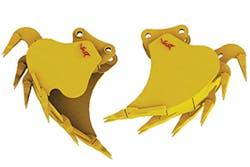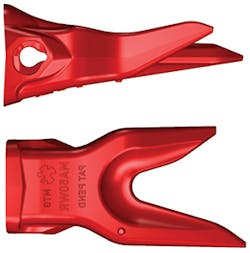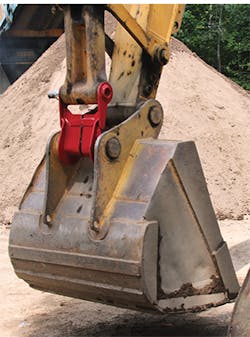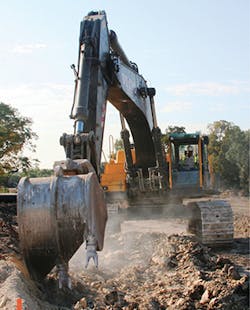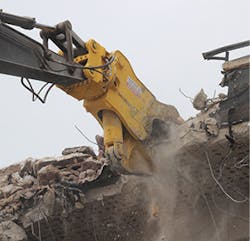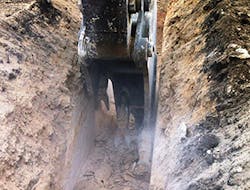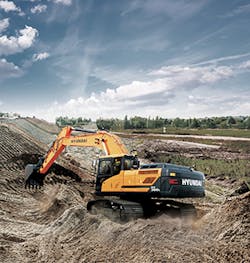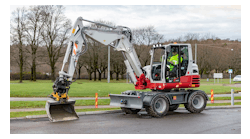There was a time when contractors thought little about the attachments that they connected to their machines. They’d invest in buckets, hammers, and thumbs and then mostly forget about them.
Those days are disappearing. Today, more contractors are doing the research necessary to find the perfect attachments for their excavators, attachments designed to boost their efficiency and productivity.
That’s a good thing, considering just how important attachments are.
Mark Mohn, director of attachments at Volvo Construction Equipment, puts it this way: Attachments are critical for excavators. Without them, there isn’t all that much excavators can do, he says.
“Without an attachment, an excavator is just an expensive and slow tractor,” says Mohn. “You can’t do anything with an excavator if you don’t have an attachment on it. Sometimes, that fact gets lost. An excavator without a bucket or hammer? All you can do is drive around with it. The part that allows you to do the work is the attachment. Attachments, then, are extremely important. You can’t forget that.”
The type of job a contractor is performing plays the most important role in what attachment this professional should use, Mohn says.
“Whenever you are buying a machine, think about the job that you want that machine to do,” he says. “Then you can pick the appropriate attachment or attachments to get the job done.”
The Versatility of Attachments
A good example? Compact or mini excavators are used for a variety of jobs. Because of this, contractors who have these machines in their fleets will want to invest in multiple attachments. The odds are high that operators of these smaller excavators will switch out to different attachments throughout the day.
Contractors, then, will have to invest in different bucket types, perhaps a small hammer attachment, and a thumb attachment to help pick up branches or rocks.
“It all depends on what type of job you need to be doing on any given day,” says Mohn.
Another big question that contractors must ask when shopping for attachments? They need to know how they will attach them to their excavators.
“The first question contractors want to answer before even picking the right bucket type is ‘What am I going to use to attach them to the machine?’” says Mohn.
Contractors who expect to switch attachments throughout the day might consider investing in quick couplers. Mohn says the most common types of these are pin grabber or universal quick couplers. Both will allow excavator operators to use a variety of attachments from different manufacturers. And they’ll be able to switch these attachments on and off their machines quickly.
Chad Wood, product development engineer with Genesis Attachments in Superior, WI, says that contractors who spend time tearing out roads or bridges and then rebuilding them can save money by investing in simpler, lower-cost linkage tools, attachments that can take on a wide variety of jobs.
For instance, Genesis manufactures the Concrete Cracker, better known as the GCC. This tool, as its name suggests, can be used to bust up concrete. These same contractors can invest in the company’s Genesis Linkage Shear, or GLS, to cut and process light to medium materials such as structural and plate steel, rebar, and pipe.
These linkage attachments don’t have the same power that a hydraulic attachment would have. But they’re also easier to install and remove, and they cost less.
“For some of the smaller contractors out there, these are great attachments to have,” says Wood. “They don’t have to subcontract out that contract or that metal work. They can do the job themselves if they have these attachments.”
Leading Edge Attachments’ AlignAttach
Flexibility
Flexibility matters to many contractors, Wood says. They need tools that do more than one job so that they can save money on their projects.
That’s why Genesis does a brisk business selling concrete-busting or steel-cutting attachments to contractors that do road work or bridge demolition. These contractors can purchase Genesis’ XLP attachment and then fit it with one or a variety of several jaw sets. Contractors, for instance, can go with a concrete jaw set when they are trying to chop through slabs of concrete and then quickly change to a steel shear jaw when they need to cut through rebar or pipe.
“That’s a good option instead of buying dedicated tool sets,” says Wood. “Contractors can instead change out the jaws without having to disconnect an attachment and install it.”
Those contractors who spend much of their time loading and transporting bulk material should consider investing in a severe-duty grapple attachment, Wood says.
Contractors who have to first demolish existing buildings or structures might rely on a severe-duty grapple to help tear down whatever needs to be demoed. They can then use the same grapple to help load the remains of that demolition into trucks. Contractors can use a grapple to load other bulk materials, too, either for transport to or from a work site.
These tools are easy to attach, too. Wood says that Genesis manufactures a severe-duty grapple that works with quick couplers, meaning that removing and attaching the tool is a relatively simple task.
The quick coupler is important, too, Wood says. It saves contractors a significant amount of time, especially when they need to switch attachments often to complete jobs. With quick couplers—as the name suggests—removing and attaching tools takes far less time.
“A lot of contractors have already made the move to quick couplers,” says Wood. “It makes sense. Anything that saves time on a job site is important for contractors. Switching between tools becomes a lot easier with these couplers. You don’t have to pound pins in or out. You just take out one pin, uncouple a tool, and then couple another one. It’s much easier.”
The Basic Toolbox
Lee Horton, owner of Leading Edge Attachments in Jefferson, MA, says that the basic attachment set all contractors should have in their toolboxes includes three buckets of different sizes and a coupler system of some sort. That gives contractors the flexibility they’d need to take on most excavation jobs, Horton says.
And then when contractors want to take on different types of jobs, such as pulverizing concrete or demolishing existing structures, they can invest in those attachments that make that work easier and more efficient, he says.
“The basic attachment system of three buckets is a really good start for contractors,” says Horton. “That arrangement can get you up and running for a wide variety of jobs.”
The three buckets that Horton recommends? Contractors should invest in a narrow bucket, a wider bucket, and then a ditching or grading bucket.
If contractors do work in rocky conditions, though, Horton recommends that they also invest in a rock-breaking or frost hook attachment.
Leading Edge Attachments also manufactures a multi-ripper attachment. This attachment can break rock and frost four times faster than a hydraulic hammer, according to Leading Edge. It also allows contractors to rip the sides and bottoms of a trench flat without any depth limitations.
“We think the multi-ripper is a universal thing to keep in your bag of tricks,” says Horton. “You can go through frost, frozen ground, frozen asphalt, and concrete without having to go out and rent a hammer. That can save contractors a significant amount of money.”
Other contractors that do a lot of grading or excavation work might also consider investing in a rake attachment, Horton says. These attachments give contractors the ability to turn their excavators into land-clearing machines. These attachments come with long and curved teeth that roll and sift the land that they cut into.
“When you use a rake to comb through the ground, it will bring rocks and roots upward with a minimum amount of force from the excavator,” says Horton. “If you use that with a thumb, it’s like operating a little grapple. You can use it to pick up rocks efficiently.”
Contractors who then add thumb attachments to their toolbox should be able to handle any grading or excavating jobs that come their way, Horton says.
“Once you have three buckets, a rock-gripping tool, and then you add a thumb to the machine, you are set,” says Horton. “If you add a rake, you have everything you need. You can rip rocks and do grading on just about any job site.”
Horton says that the combination of bucket and thumb is an especially useful one. With these two attachments, contractors can clear brush, take on demolition work, pick up rocks and material, and dig. And contractors don’t necessarily have to invest in more expensive hydraulic versions of, say, a thumb attachment to be successful.
Multi-Ripper Bucket
Yes, hydraulic thumbs do provide the most power. But they are also the most expensive. Most contractors can work effectively with a mechanical thumb attachment if they are worried about the higher upfront costs of a hydraulic version, Horton says.
“The mechanical thumb is not quite as useful as a hydraulic thumb is,” says Horton. “But if you’re just using it for brush, it’s fine.”
What factors should contractors consider when they are debating which attachments to add to their job site toolboxes? Wood says they should first consider how often they expect to take on a particular job type.
For instance, contractors who will be demolishing bridges on a regular basis or who expect to tackle several concrete-demolition projects should invest in an attachment dedicated solely for that job. Such dedicated attachments will perform better and offer greater power.
However, those contractors who need to bust through concrete only on an infrequent basis or who expect to demolish bridges only on the rarest of jobs should consider investing in a more flexible attachment, such as one that allows them to switch out jaws for specific work.
“When you use an attachment that lets you switch out jaws, you do lose some performance,” says Wood. “You might be 20% less productive than if you were using a dedicated shear for steel work or a dedicated concrete tool. But the non-dedicated tools are less expensive and provide more flexibility. You can use them for a greater number of jobs. But if you are doing one type of job on a consistent basis, you should invest in a dedicated attachment for that type of work. Then, you’ll want the extra performance and power that a dedicated attachment can provide.”
Still Work to Do
The problem? Even with a greater focus on attachments, some contractors still put little thought into which ones they purchase. Or if they do think about which attachments are best, they make their decisions based purely on price, investing in the lowest-cost alternative.
“That can be a bad business decision,” says Wood. “Contractors really need to look first at the work they do. That should be their first consideration. If you are only doing a job once, it might take you a little longer to finish it, but a lower-cost attachment might be fine. If you are doing a certain type of job day in and day out, though? You should have a dedicated shear to do that, even if it does cost a bit more.”
Wood, though, says that contractors are improving when it comes to researching attachments. And this research is leading them to invest in a wider variety of attachments for their excavators, he says.
“Years ago, contractors would buy a bucket and thumb and think they could do whatever they needed to do with those two attachments,” says Wood. “They’d have a job where they’d have to remove a building before building a new one or they needed to tear out a bridge, and they’d use a bucket and thumb. Now it is moving away from that very basic setup.”
This is making contractors more efficient. Today’s attachments are designed to tackle specific jobs. That’s important; an attachment designed only for breaking up concrete will do a better, and quicker, job of that then will a catch-all attachment built to handle all jobs but master none of them.
Wood says that he expects contractors to continue to invest more in attachments as they realize that the right tools make it easier, and less expensive, to complete jobs. That’s something that can have a positive impact on these contractors’ bottom lines.
“In the old days, you’d see contractors break their thumb attachments pretty often,” says Wood. “They were using thumbs and buckets for everything because that’s all they had at the time. People are getting better now. They are looking closer at the attachments available to them. They might see a shot of an attachment online breaking concrete. It makes them think that it might be a good tool for them. It’s not all the way there yet, but it is getting there.”
When deciding which attachments to buy, Horton recommends that contractors first look at the quality of the materials involved.
The Genesis Razer demolition tool
“Some attachments just aren’t strong enough to handle some of the work that contractors do,” he says. “You might see some inferior product out there. You might get that product for a lower price, but it won’t perform as well, and that can cost you money in the long run.”
Horton says that the shape of buckets is important, too. Buckets with curves that have small radiuses and flat fronts that stick out too far might give contractors the right capacity, but the heel of the bucket might also slam too hard into the dirt.
What contractors want are buckets that, when they are digging, don’t scrape on the ground, Horton says.
“Good designs will minimize the amount of maintenance you need,” he says. “The whole goal is productivity. You want to be able to do your job and do it as fast as you can. You want to spend the minimum amount of time maintaining your attachments. The size of the attachment for the job and the materials and the design are the most important things. You want them to match up with what you are doing.”
Attachments today are increasingly versatile, a benefit for contractors who are looking to save money on their equipment costs. These contractors can reduce their upfront spending if they can find attachments that can perform several different jobs.
It’s a more cost-effective move than is buying several different attachments for every different job required on a job site.
Wood points to the Genesis Concrete Processor—or GCP—attachment. This demolition attachment allows excavators to crush or pulverize concrete.
Wood says that the attachment was originally designed to pulverize concrete slabs. But contractors now use the attachment to demolish concrete walls or in quarries to break up chunks of concrete or rock.
Multi-Ripper Talon Bucket
“That is not what was originally thought when the attachment was being designed,” says Wood. “But contractors have moved away from the original intent to take on other jobs with this same tool. A lot of companies used to just do dirt work. Now they are moving to some demolition. They want their machines to be able to do more.”
By choosing versatile attachments, contractors can squeeze more production out of their excavators. Machines won’t spend as much time sitting idle on a job site if attachments allow them to take on a wider variety of jobs, Wood says.
“A lot of times, a machine might have a job to do, and then it sits,” says Wood. “Now contractors want their machines to be more productive. They want to use them throughout more of the year. If dirt work is slow, they can do some demolition. There are now more jobs they can bid on and actually get. Without the attachments, they might not be able to do that. They might not have been able to do that before.”
The job site also matters, Mohn says. With the right attachments, contractors can boost their efficiency levels in any type of job site.
Digging conditions, for instance, matter. Contractors need to consider whether they will be digging in rocky soil or whether they’ll be digging deep trenches. Are they tackling grading work?
Each type of job and job site can require a different type of bucket, Mohn says. Contractors who are going to be breaking rock or doing demolition work might need a hammer or some type of shears on their excavators.
“There is a wide variety of attachments that they can be looking at depending on the job site and application,” says Mohn.
Choosing the wrong type of bucket or size bucket can cause problems, Mohn says. That’s why it’s so important for contractors to do their research before selecting their buckets and attachments.
Contractors who pick buckets that aren’t the right size for a job might end up digging trenches that are too wide. If they don’t have the proper teeth, they won’t be able to break through a job site’s rocky soil. Maybe they want to be as productive as possible, but they have a bucket that’s simply too small. They won’t be able to move as much dirt as quickly as they might like, Mohn says.
“It takes them longer to get the job done,” says Mohn. “It is truly important to match the bucket with the application and the machine itself. It comes down to what you are trying to accomplish.”
Contractors can also increase their efficiency by choosing the correct buckets, Mohn says.
For instance, if you need to load loose fill on a job site, using a bucket with teeth can result in more work. That’s because a toothed bucket will spill more dirt than will a bucket without teeth. And that results in more fuel being consumed during the cleanup of the spillage.
“You can spend millions of dollars trying to get better fuel efficiency, or you can design a better bucket to get better fuel efficiency for far less,” he says.
Contractors today are more comfortable exploring new types of attachments, Mohn says. That includes the rock wheel attachment, which he says is growing in popularity.
This attachment type features rotating cutting heads. These heads move fairly slowly. But they are powerful, meaning that contractors can use them for demolition, including cutting through concrete. Contractors can use these powerful attachments, too, for digging trenches.
Mohn says that Volvo has demonstrated this attachment for potential customers and that these customers invariably come away impressed with the versatility and power of it.
“It reduces the concrete or limestone to, basically, dust,” says Mohn. “It’s a good alternative to using a hammer or breaker. It’s a good alternative for breaking things into smaller pieces.”
A Hyundai HX300L at work
More Experimentation
The rising interest in such a tool is evidence that contractors are willing to experiment with attachments today, Mohn says. No longer are they content to force an attachment to take on a job that might not be a good fit for it, he says.
“There are jobs where you can’t use a hammer too close to a building because of the vibration,” says Mohn. “You can use this attachment instead to get the job done. It’s a unique and versatile tool.”
The North American market is still a bit finicky, though, when it comes to attachments, Mohn says. To sell a new attachment here, manufacturers must often demonstrate them first.
“You have to really sell customers on how the attachment is going to make them more productive and how it will help them save more money in the long term,” says Mohn. “As we get more of these attachments out there, and as we do more promotion, we will see more people embracing these attachments and using them to get more of their jobs done.”
While attachments are evolving, they aren’t getting quite as high-tech as are some of the machines with which they are working.
Machine control and telematics, of course, have become crucial tools for contractors who want to complete their jobs quickly and with fewer mistakes. This technology can prevent excavators, for instance, from digging trenches that are too deep. This increases a contractor’s productivity and reduces time spent wasted on fixing job site mistakes.
“This technology is important. Say you have a dig-assist technology on a machine. If you want to dig a 10-foot trench, the dig-assist won’t let you dig any lower than that 10 feet,” says Mohn.
Attachments, though, aren’t being configured any differently to work with machine control technology or telematics.
“The attachments help the machine get the job done,” says Mohn. “But there is nothing yet that is actually tied to the dig-assist when it comes to buckets or other attachments.”